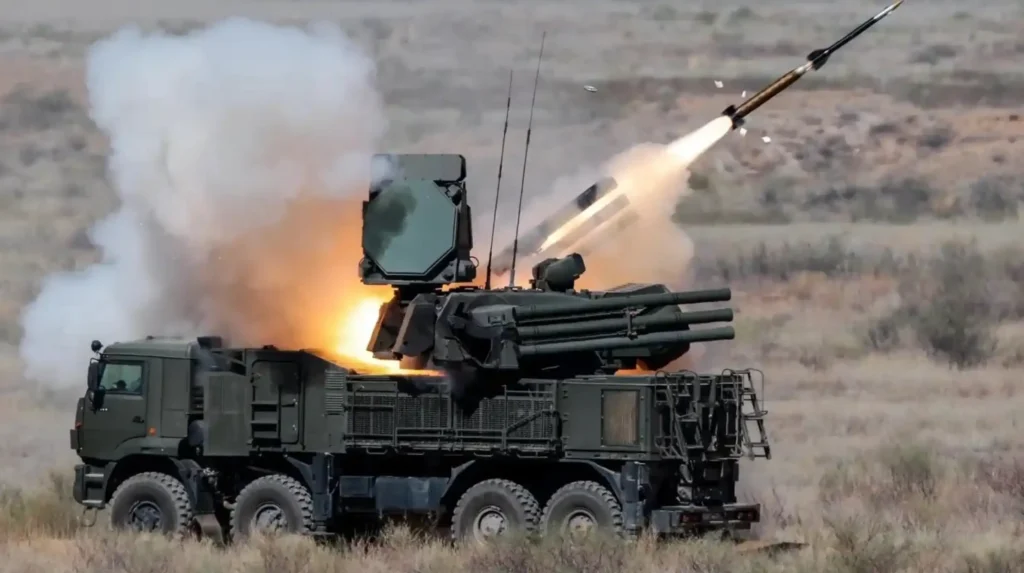Follow Us:

Share
Türkiye Unveils Gürz 150, marking a significant advancement in modern air defense as nations continuously seek cutting-edge systems to counter emerging threats such as UAV swarms, cruise missiles, and precision-guided munitions.
Türkiye has positioned itself as a key player in this domain with the introduction of the Gürz 150, a highly advanced hybrid air defense system developed by Aselsan.
First showcased in 2024 at major defense exhibitions such as the World Defense Show in Saudi Arabia and SAHA 2024 in Türkiye, the Gürz 150 is designed to provide multi-layered air and missile defense
This system is a direct competitor to Russia’s Pantsir-S1, which has been widely used in various conflict zones but has also faced challenges in modern warfare.
The Gürz 150 stands out due to its ability to engage multiple types of threats with both kinetic and electronic countermeasures, giving it an edge over traditional systems.
The Gürz 150 is built as a hybrid air defense system, integrating hard-kill and soft-kill mechanisms to neutralize aerial threats efficiently. It is designed for both autonomous operations and networked engagements, where multiple units work together under a unified command structure.

One of the system’s most notable features is its 35mm automatic cannon, capable of firing air-bursting ammunition to destroy fast-moving targets such as drones and incoming missiles. Unlike traditional air defense systems that rely solely on projectile-based defenses, the Gürz 150 also incorporates land-based variants of the Gökdoğan and Bozdoğan air-to-air missiles, providing enhanced reach and accuracy.
Radar and sensor technology play a crucial role in the effectiveness of an air defense system. The Gürz 150 is equipped with active electronically scanned array (AESA) radar, which offers superior target tracking and engagement capabilities.
It also features integrated IFF (Identification Friend or Foe) capabilities, an electro-optical targeting suite, and an advanced fire control system that enables rapid response to airborne threats.
Electronic warfare is a key component of modern air defense, and the Gürz 150 excels in this area. It includes RF jamming, electromagnetic spoofing, and the Kangal electronic warfare system, which can disrupt and disable enemy drones and missiles before they even reach their target.
Additionally, the system is equipped with the Gökberk laser weapon, designed to neutralize small UAVs and swarm threats, further expanding its defensive capabilities.
Mobility is another strength of the Gürz 150, as it is mounted on an 8×8 wheeled tactical vehicle. This ensures high mobility and rapid deployment, allowing operators to reposition the system quickly based on battlefield conditions. The fire-on-the-move capability enables it to engage targets while in motion, a feature that is critical in dynamic combat environments.
Russia’s Pantsir-S1 has been in service for years, providing short-to-medium-range air defense with a combination of surface-to-air missiles (SAMs) and rapid-firing automatic cannons. It has been deployed in multiple conflicts and has gained a reputation for being effective against a wide range of aerial threats, including aircraft, helicopters, and UAVs.
The Pantsir-S1 is armed with twelve 57E6 surface-to-air missiles, capable of engaging targets at distances up to 20 km with a maximum altitude of 15 km. Additionally, it features two twin-barrel 30mm 2A38M automatic cannons, which provide close-range defense. The system relies on a dual-band radar and electro-optical sensors for target detection and tracking.

Despite its combat effectiveness, the Pantsir-S1 has faced notable challenges in modern warfare. Reports from recent conflicts indicate that small UAVs and precision-guided munitions have been able to evade detection and strike Pantsir-S1 units. This has led to the ongoing development of upgraded radar and tracking systems to improve its responsiveness against emerging threats.
When compared to the Gürz 150, the Pantsir-S1 lacks some key modern features. The Gürz 150 integrates electronic warfare capabilities, such as RF jamming and spoofing, which can significantly enhance survivability against drone attacks and guided munitions.
Additionally, the fire-on-the-move capability of the Gürz 150 gives it greater flexibility in combat scenarios, whereas the Pantsir-S1 is primarily designed for stationary defense.
Another major distinction is the modular and upgradeable nature of the Gürz 150. Türkiye has designed the system with future enhancements in mind, allowing for the integration of new sensors, missiles, and countermeasures as needed.
The Pantsir-S1, on the other hand, has required constant refinements to address its vulnerabilities, which can be a limitation in rapidly evolving combat scenarios.
With the Gürz 150 entering serial production in 2024, Türkiye is establishing itself as a major player in the global air defense market. The system’s blend of kinetic and electronic countermeasures, advanced radar technology, and high mobility makes it a formidable alternative to existing platforms like the Pantsir-S1.
As modern warfare increasingly involves autonomous drones, loitering munitions, and cruise missile threats, air defense systems must adapt quickly.
The Gürz 150’s multi-layered defense strategy, which includes hard-kill weapons, electronic warfare, and laser technology, ensures that it remains effective against evolving threats.
This places it in a strong position not only for Türkiye’s defense forces but also for international buyers seeking advanced air defense solutions.
While the Pantsir-S1 remains a widely used system, its operational vulnerabilities have been exposed in recent conflicts, prompting the need for continual upgrades.
In contrast, the Gürz 150 has been developed with modern threats in mind, making it a highly adaptable and future-proof solution.
As Türkiye continues to invest in defense technology and strengthen partnerships with allied nations, the Gürz 150 could emerge as a new benchmark in mobile air defense systems. With its advanced capabilities, modular design, and superior electronic warfare integration, it has the potential to redefine how nations approach air defense in the 21st century.
Share
Defense Feeds is publication focusing on informing, engaging, and empowering the world by providing accurate information from defense technology.
Powered by Defense Feeds © 2025 – All rights reserved.